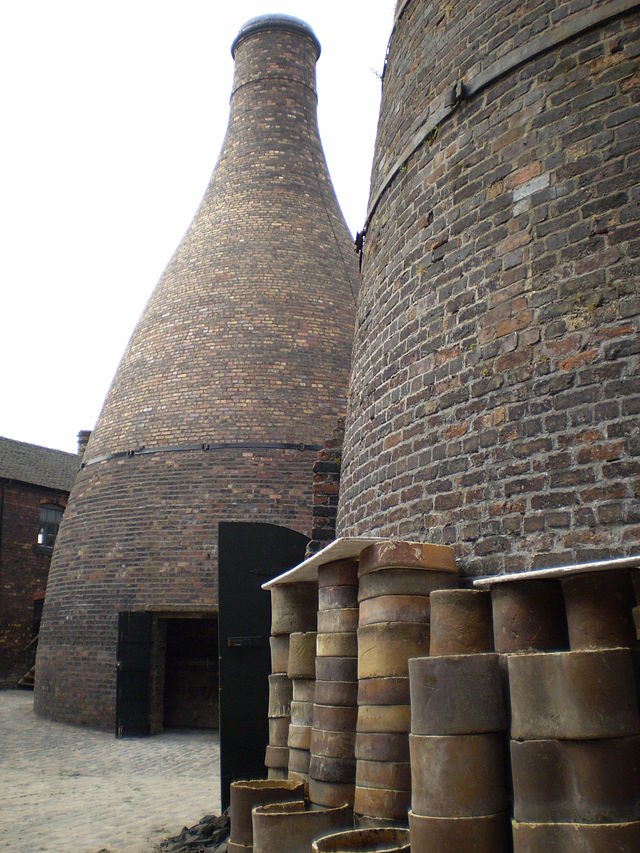Loading AI tools
Historic ceramic-producing region within the present Stoke-on-Trent, Staffordshire, England From Wikipedia, the free encyclopedia
The Staffordshire Potteries is the industrial area encompassing the six towns Burslem, Fenton, Hanley, Longton, Tunstall and Stoke (which is now the city of Stoke-on-Trent) in Staffordshire, England.[1] North Staffordshire became a centre of ceramic production in the early 17th century,[2] due to the local availability of clay, salt, lead and coal.


Hundreds of companies produced all kinds of pottery, from tablewares and decorative pieces to industrial items. The main pottery types of earthenware, stoneware and porcelain were all made in large quantities, and the Staffordshire industry was a major innovator in developing new varieties of ceramic bodies such as bone china and jasperware, as well as pioneering transfer printing and other glazing and decorating techniques. In general Staffordshire was strongest in the middle and low price ranges, though the finest and most expensive types of wares were also made.[3]
By the late 18th century North Staffordshire was the largest producer of ceramics in Britain, despite significant centres elsewhere, and relied heavily on child labor throughout the production process.[4] Large export markets took Staffordshire pottery around the world, especially in the 19th century.[5] Production began to decline in the late 19th century, as other countries developed their industries. After World War II it declined steeply. Production continues in the area, but at a small fraction of the levels at the peak of the industry.[citation needed]
The boom came after the discovery in 1720 by potter John Astbury of Shelton, that by adding heated and ground flint powder to the local reddish clay he could create a more palatable white or Creamware. The flint was sourced from either the South Coast of England or France, then shipped to the Port of Liverpool or to Shardlow on the River Trent.[6] After shipping by pack horses to the watermills local to the potteries, or to commercial flint grinding mills in either the Churnet Valley or Moddershall Valley, it was sorted to remove flint that had reddish hues, then heated to 1,200 °C (2,200 °F) to create an easily ground product.[6] A group involving James Brindley later patented a water-based process that reduced the generation of fine siliceous dust, lessening workers' risk of developing silicosis. In the early 1900s the process was converted to grinding bone, which had a similar effect.[6][7]
With the coming of pottery products distribution by railway that began in the 1840s, mainly by the London and North Western Railway and Midland Railway, there was a considerable increase in business.[citation needed]
Potteries active in the 19th century include Spode, Aynsley, Burleigh, Doulton, Dudson, Mintons, Moorcroft, Davenport, Twyford, and Wedgwood.
The Chartist 1842 General Strike was ignited by striking miners at collieries in the Potteries, and led to the 1842 Pottery Riots.
William Hines and his brother Thomas Hines established the pottery firm Hines Brothers in Fenton, Stoke-on-Trent and built Heron Cross Pottery[8] in 1886, particularly making the classic brown earthenware teapots and tea services for the London Midland and Scottish Railway. The business was taken over in 1907 and became the Kensington Pottery in Hanley in about 1922: this pottery continued until 1937.
It is understood that in about 1850 William Hines was born either in Ellesmere, Shropshire or in St Oswalds, Welsh Marches. He married Mary Mellor on 10 March 1875 and remarried when she died (reportedly not until the evening of his marriage telling his second wife that he already had six children). He became a prominent rider in the North Staffordshire Hunt[9] and owner of a stable of horses. He spent considerable money building Wesleyan chapels. There is a Hines Street in Fenton.[10][11]
Seamless Wikipedia browsing. On steroids.
Every time you click a link to Wikipedia, Wiktionary or Wikiquote in your browser's search results, it will show the modern Wikiwand interface.
Wikiwand extension is a five stars, simple, with minimum permission required to keep your browsing private, safe and transparent.